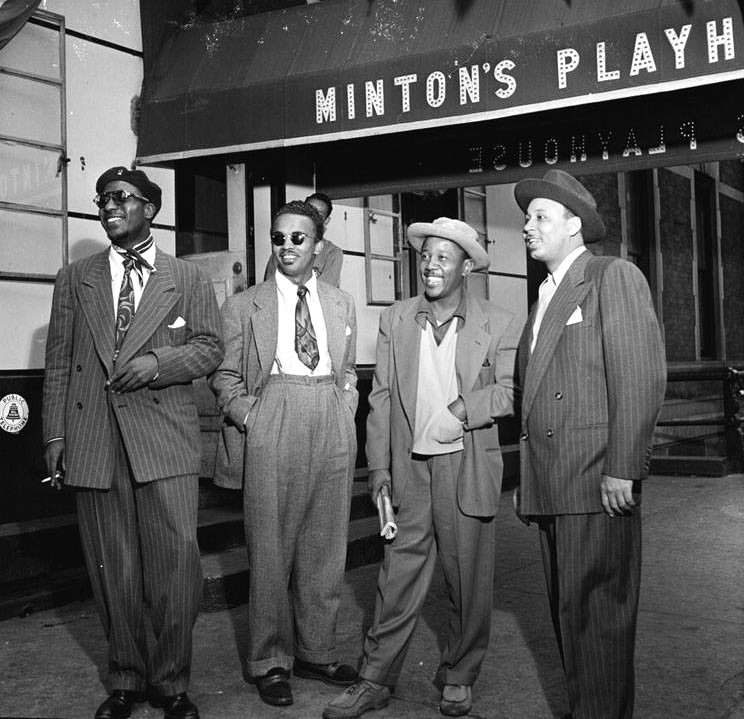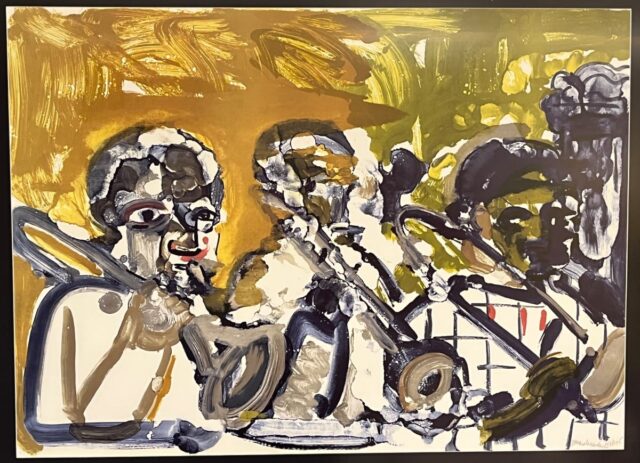Romare Bearden (American, 1911-1988)
Brass Section (Jamming at Minton’s), from the “Jazz” series, 1979
Lithograph in colors on paper
24.75 x 32.5 in.
Gift of Carol Quillen, 18th President of Davidson College, and George McLendon
It is difficult to capture the essence of sound through visual media. Already is it difficult to translate music into a visual language. It becomes even more complicated when that music is jazz. Jazz is as expansive as any other music genre, consisting of a myriad of subgenres and styles, making it impossible to pigeonhole. That’s why jazz is just as often associated with easy-listening, elevator music, as it is known for being incredibly challenging. Yet, jazz at its most challenging has pushed the boundaries of not only what music in its genre can sound like, but also popular music and music in general. At its core, jazz is an improvisational music genre that requires intuition and precise judgment from a single player, as well as a sort of telekinesis for a small group or big band. It is these elements that make jazz such a difficult music to express visually. If too technical, an art piece can lose the fluidity and spontaneity that are hallmarks of the most arresting works of jazz. That is not to say jazz is slim on technique (which could not be further from the truth; simply listen to 5 seconds of “Giant Steps” by John Coltrane to remove any doubts), rather, it is more appropriate to recognize jazz as never being confined to the trappings of technicalities. Some of the greatest players have challenged, bent, and shattered what is to be expected of jazz. For a great example, see Ornette Coleman. He was the progenitor of a movement within jazz called “free jazz.” “Free” from any typical music structures and foundations, much of his music sounds scattered, atonal, and/or hardly like music. It is almost like the musical form of abstract visual art.
To capture jazz statically is where it gets most difficult. It’s like taking a snapshot of a sprinter mid-race. The movement is rapid mid-performance, and the energy is high. Yet Romare Bearden has expertly translated that into his work Brass Section (Jamming at Minton’s) from his Jazz series.
Romare Bearden, a North Carolina native, brings his multifaceted interests and talents to the table, giving an edge in conveying the subject matter so succinctly. Not only was he a multimedia artist, but he was also an author and, most relevantly, a songwriter. Not obscure by any means, his most notable composition, “Sea Breeze,” was covered by giants such as Billy Eckstine, Dizzy Gillespie, Tito Puente, and Yusef Lateef. His involvement in music, beyond being a casual listener, provides Bearden with a truer comprehension of what goes on in the realm of musicians. Bearden’s clear appreciation and deep understanding of jazz music, its culture, and its players are realized in this piece, as well as many other works tackling similar subjects.

Famed Minton’s players, Thelonious Monk, Howard McGhee, Roy Eldridge, and Teddy Hill
Bearden’s artwork was never limited to simply depicting the jazz scene and its surrounding culture in the halls of an art gallery. On various occasions, jazz musicians have utilized or even sought his hand to craft album art that expresses the music within the product. His abstract painting style can be found on a Clifford Brown/Max Roach album, while his more famous collage compositions grace the album covers of artists as varied as Billie Holiday, Donald Byrd, The Roots, and each of the Marsalis Brothers. Branford Marsalis, the saxophonist of the brothers, even made a whole tribute album dedicated to Romare Bearden called Romare Bearden Revisited, featuring a cover of Bearden’s “Sea Breeze,” and other compositions that Bearden titled certain works after. Even Brass Section was used by trombonist Robin Eubanks on his album, Get 2 It, a title that matches the energy felt in this piece.
To add to its already interesting subject matter, Brass Section is something of a historic work, as the Minton’s in the title is the name of a real, incredibly significant jazz club in Harlem, New York. Equally historically important and relevant now (the jazz club continues to stay open, while also being registered under the U.S. National Register of Historic Places), the jazz club has a rich tradition of jam sessions and jazz duels. Founded in 1938 by Henry Minton, this club became a hotspot for jazz veterans and young, innovative musicians alike. It was well-known for its energetic performances that contributed to the birth of bebop, one of the most significant and lively styles of jazz. Jazz greats such as Dizzy Gillespie, Charlie Christian, Charlie Parker, Thelonious Monk, and Miles Davis, to name a few, were some frequenters of this club. Some great live recordings have even been released from sessions at Minton’s, too, featuring the likes of Monk and Stanley Turrentine. To depict Minton’s, a place where the rapidly paced bebop was formed, meant that sheer energy would have to be captured on the canvas.

The Minton’s Jazz Club
Luckily for us, Bearden knew exactly how to capture this. The brushstrokes, thick and fluid, look as if they were rapidly smeared on. Especially in the background, you can see that the brushstrokes leave white space in their wake. As a jazz musician instinctively recognizing when to leave space between each note, Romare Bearden has utilized the white space to free up, complement, and even complete the work. The musicians, like their playing, overlap with each other, the background, and the blank space. As a result, their forms are left incomplete and abstract. Instead, the clearest element in the portrait is not any tangible subject or object, but simply the energy of masters finely tuning their craft. The yellowish background is reminiscent of this same energy, as the color represents the vigor and joy these musicians evoke through their camaraderie of musicianship.
Through Brass Section and numerous other works, Romare Bearden was an artist who left an indelible mark on the jazz scene and a notable impression on popular music as a whole. For example, the fact that his recognition even extends to contemporary hip-hop artists (i.e., The Roots) is further proof of rap’s jazz lineage. His contributions to creatively depicting jazz musicians were only part of his larger mission of addressing what it was to be African-American in the United States, oftentimes in the contentious historical South, where he once called home. The Brass Section’s subject of a New York jazz club contributes to the discourse by mimicking the energy rather than the visual details of jazz and its musicians, a music tradition deeply tied to its origins in African-American communities. To capture this energy, as Bearden often did, is a testament to his excellent understanding of visual art, music, and the surrounding community.
Be sure to check out this work and the many others in our collection across campus!
– Caleb Machorro ’28
Also! Listen here for the music mentioned in this article, featuring many inspired by and connected to Romare Bearden.

